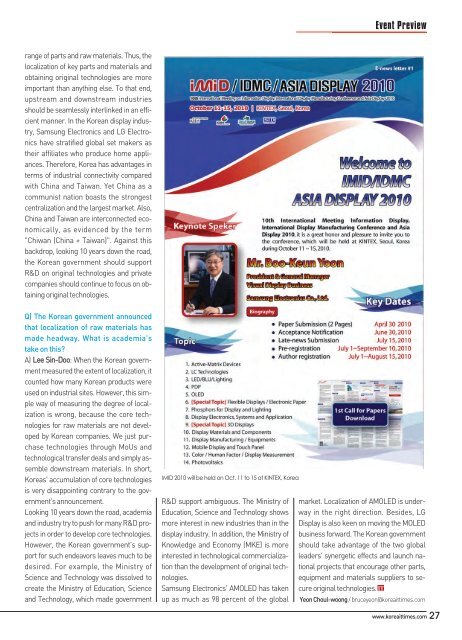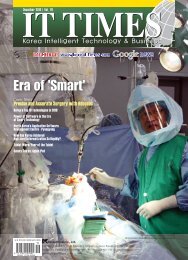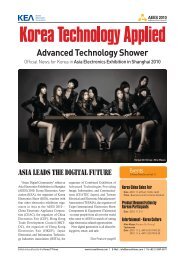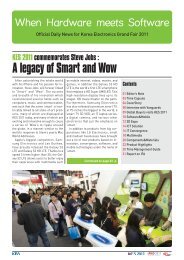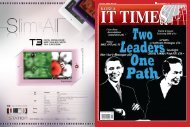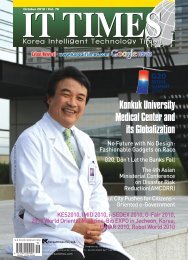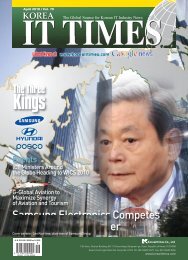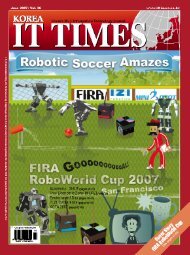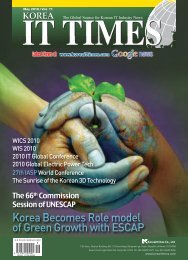2010-07 - Korea IT Times
2010-07 - Korea IT Times
2010-07 - Korea IT Times
Create successful ePaper yourself
Turn your PDF publications into a flip-book with our unique Google optimized e-Paper software.
Event Preview<br />
range of parts and raw materials. Thus, the<br />
localization of key parts and materials and<br />
obtaining original technologies are more<br />
important than anything else. To that end,<br />
upstream and downstream industries<br />
should be seamlessly interlinked in an efficient<br />
manner. In the <strong>Korea</strong>n display industry,<br />
Samsung Electronics and LG Electronics<br />
have stratified global set makers as<br />
their affiliates who produce home appliances.<br />
Therefore, <strong>Korea</strong> has advantages in<br />
terms of industrial connectivity compared<br />
with China and Taiwan. Yet China as a<br />
communist nation boasts the strongest<br />
centralization and the largest market. Also,<br />
China and Taiwan are interconnected economically,<br />
as evidenced by the term<br />
"Chiwan (China + Taiwan)". Against this<br />
backdrop, looking 10 years down the road,<br />
the <strong>Korea</strong>n government should support<br />
R&D on original technologies and private<br />
companies should continue to focus on obtaining<br />
original technologies.<br />
Q) The <strong>Korea</strong>n government announced<br />
that localization of raw materials has<br />
made headway. What is academia's<br />
take on this?<br />
A) Lee Sin-Doo: When the <strong>Korea</strong>n government<br />
measured the extent of localization, it<br />
counted how many <strong>Korea</strong>n products were<br />
used on industrial sites. However, this simple<br />
way of measuring the degree of localization<br />
is wrong, because the core technologies<br />
for raw materials are not developed<br />
by <strong>Korea</strong>n companies. We just purchase<br />
technologies through MoUs and<br />
technological transfer deals and simply assemble<br />
downstream materials. In short,<br />
<strong>Korea</strong>s' accumulation of core technologies<br />
is very disappointing contrary to the government's<br />
announcement.<br />
Looking 10 years down the road, academia<br />
and industry try to push for many R&D projects<br />
in order to develop core technologies.<br />
However, the <strong>Korea</strong>n government's support<br />
for such endeavors leaves much to be<br />
desired. For example, the Ministry of<br />
Science and Technology was dissolved to<br />
create the Ministry of Education, Science<br />
and Technology, which made government<br />
IMID <strong>2010</strong> will be held on Oct. 11 to 15 at KINTEX, <strong>Korea</strong><br />
R&D support ambiguous. The Ministry of<br />
Education, Science and Technology shows<br />
more interest in new industries than in the<br />
display industry. In addition, the Ministry of<br />
Knowledge and Economy (MKE) is more<br />
interested in technological commercialization<br />
than the development of original technologies.<br />
Samsung Electronics' AMOLED has taken<br />
up as much as 98 percent of the global<br />
market. Localization of AMOLED is underway<br />
in the right direction. Besides, LG<br />
Display is also keen on moving the MOLED<br />
business forward. The <strong>Korea</strong>n government<br />
should take advantage of the two global<br />
leaders' synergetic effects and launch national<br />
projects that encourage other parts,<br />
equipment and materials suppliers to secure<br />
original technologies.<br />
Yeon Choul-woong/ bruceyeon@koreaittimes.com<br />
www.koreaittimes.com 27


